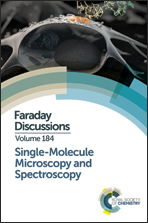Millisecond single-molecule localization microscopy combined with convolution analysis and automated image segmentation to determine protein concentrations in complexly structured, functional cells, one cell at a time
Abstract
We present a single-molecule tool called the CoPro (concentration of proteins) method that uses millisecond imaging with convolution analysis, automated image segmentation and super-resolution localization microscopy to generate robust estimates for protein concentration in different compartments of single living cells, validated using realistic simulations of complex multiple compartment cell types. We demonstrate its utility experimentally on model Escherichia coli bacteria and Saccharomyces cerevisiae budding yeast cells, and use it to address the biological question of how signals are transduced in cells. Cells in all domains of life dynamically sense their environment through signal transduction mechanisms, many involving gene regulation. The glucose sensing mechanism of S. cerevisiae is a model system for studying gene regulatory signal transduction. It uses the multi-copy expression inhibitor of the GAL gene family, Mig1, to repress unwanted genes in the presence of elevated extracellular glucose concentrations. We fluorescently labelled Mig1 molecules with green fluorescent protein (GFP) via chromosomal integration at physiological expression levels in living S. cerevisiae cells, in addition to the RNA polymerase protein Nrd1 with the fluorescent protein reporter mCherry. Using CoPro we make quantitative estimates of Mig1 and Nrd1 protein concentrations in the cytoplasm and nucleus compartments on a cell-by-cell basis under physiological conditions. These estimates indicate a ∼4-fold shift towards higher values in the concentration of diffusive Mig1 in the nucleus if the external glucose concentration is raised, whereas equivalent levels in the cytoplasm shift to smaller values with a relative change an order of magnitude smaller. This compares with Nrd1 which is not involved directly in glucose sensing, and which is almost exclusively localized in the nucleus under high and low external glucose levels. CoPro facilitates time-resolved quantification of protein concentrations in single functional cells, and enables the distributions of concentrations across a cell population to be measured. This could be useful in investigating several cellular processes that are mediated by proteins, especially where changes in protein concentration in a single cell in response to changes in the extracellular chemical environment are subtle and rapid and may be smaller than the variability across a cell population.
- This article is part of the themed collection: Single-Molecule Microscopy and Spectroscopy

 Please wait while we load your content...
Please wait while we load your content...